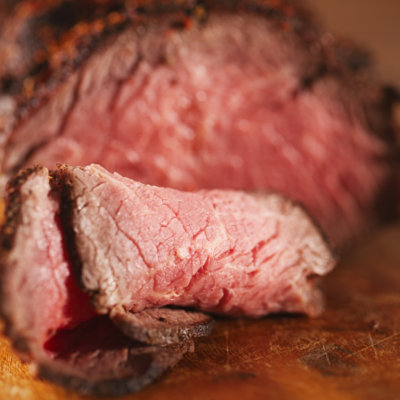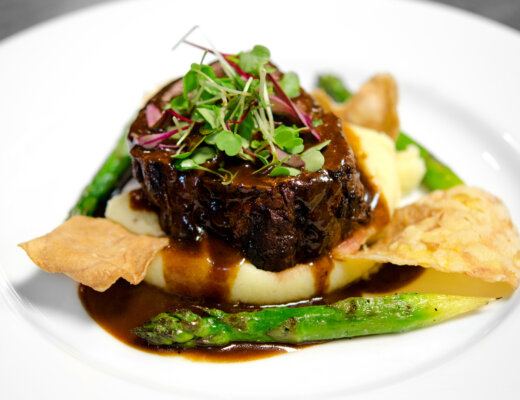The bavette is larger and tapered on both ends weighing about 3 ½ to 4 pounds. In my opinion, I feel the bavette is best to be cut thinner and treated just like a skirt steak. Tri-tip, on the other hand, is smaller and weighs 2 to 3 pounds. Tapered on one end, it is best prepared whole. Though different, both are highly marbled and delicious.
Recipe
Equipment
2 – medium-sized mixing bowls – We have this set of Fresco plastic mixing bowls, which we love. They’re easy to clean, durable, and lightweight. Not only that, but they’re really inexpensive. I prefer plastic mixing bowls because they don’t retain heat or coldness in the same way that metal ones do, and when you’re mixing products you want them as close to room temperature as possible.
Large Pan – Something preferably stainless, like the set below, and with enough surface area so that the mixture in this recipe can really reduce. You want some weight in your pans, which normally equals good quality!
Dutch Oven – You don’t to go super high-dollar here. There are a lot of quality Dutch Ovens for a good value on Amazon.
Ingredients
4-5 Pounds of Sirloin Beef
2 Tablespoons Olive Oil
2 whole Yellow Onions
6 whole Carrots
Salt To Taste
Pepper To Taste
1 cup Red Wine -use something good enough that you would drink
2-3 Cups Beef Stock
3 sprigs Fresh Thyme, or more to taste
3 sprigs Fresh Rosemary, or more to taste
Instructions
Chop the sirloin into 1″ squared cubes, leaving on the fat where it is. Salt and pepper the sirloin and set aside in a bowl.
Heat a large pan or dutch over medium-high heat with 2-3 tablespoons of olive oil. We also like to add a touch of butter, but that’s optional.
Peel and cut the onions in slices, and chop the carrots into small chunks. Just a normal carrot cut into medallions will do. Add the vegetables into hot oil.
Add your meat and let sear until it’s brown, and the onions have become a little lighter in color.
Add wine and broth to deglaze the pan, and stir the mixture.
Cover and reduce heat to low-medium heat, and let cook one-hour per pound of meat. Open the lid periodically and stir content.
Additional Tips for Cooking Tri-Tip Roast
Tri-tip roast is a popular cut of beef that is known for its tender and flavorful meat. Cooking tri-tip roast can be a bit tricky, but with the right techniques and tips, you can achieve a delicious and succulent dish. Here are some important tips to remember while cooking tri-tip roast:
- Choose the Right Cut: The first step in cooking tri-tip roast is to choose the right cut of meat. Look for a well-marbled, boneless roast that weighs between 2-3 pounds. The fat marbling will ensure that the meat is tender and juicy when cooked.
- Season the Meat: Tri-tip roast has a mild flavor, so it is important to season it well before cooking. Use a dry rub or marinade to infuse flavor into the meat. Some popular seasonings for tri-tip roast include garlic powder, onion powder, paprika, salt, and black pepper.
- Preheat the Oven: Preheat your oven to 425°F before you start cooking. This will ensure that the oven is hot enough to sear the meat and develop a nice crust on the outside.
- Sear the Meat: Searing the meat is an important step in cooking tri-tip roast. Heat a cast-iron skillet on high heat and add a tablespoon of oil. When the oil is hot, add the tri-tip roast and sear it on all sides for about 2-3 minutes per side. This will help to lock in the juices and create a nice crust on the outside of the meat.
- Use a Meat Thermometer: To ensure that your tri-tip roast is cooked to perfection, use a meat thermometer to check the internal temperature. The ideal temperature for medium-rare tri-tip roast is 135°F. Insert the thermometer into the thickest part of the meat to get an accurate reading.
- Let it Rest: After cooking, let the tri-tip roast rest for at least 10 minutes before slicing. This will allow the juices to redistribute throughout the meat, making it more tender and flavorful.
- Slice Against the Grain: When slicing tri-tip roast, it is important to cut against the grain. This will make the meat more tender and easier to chew. Look for the lines of muscle fibers on the meat and cut perpendicular to them.
- Serve with Sauce: Tri-tip roast is delicious on its own, but it can be even better with a flavorful sauce. Consider serving it with a chimichurri sauce, a horseradish cream sauce, or a red wine reduction.
- Consider Grilling: Tri-tip roast can also be cooked on the grill for a smoky, charred flavor. Preheat the grill to high heat and sear the meat on both sides for a few minutes. Then, move it to a cooler part of the grill and cook it for about 20-30 minutes, turning it occasionally, until it reaches the desired temperature.
Mistakes to Avoid While Cooking Tri-Tip Roast
Tri-tip roast is a delicious cut of beef that can be cooked in a variety of ways. However, even experienced cooks can make mistakes when preparing this cut of meat. Here are some common mistakes people make when cooking tri-tip roast, some of which mirror the suggestions above:
- Not trimming the fat: Tri-tip roast has a layer of fat on one side, and it’s important to trim it before cooking. Leaving too much fat on the roast can result in a greasy, chewy texture.
- Overcooking: Tri-tip roast is best served medium-rare to medium, but many people overcook it, resulting in a tough and dry piece of meat. It’s important to use a meat thermometer and remove the roast from the oven when it reaches an internal temperature of 130-135°F.
- Not letting it rest: After cooking, it’s important to let the tri-tip rest for at least 10-15 minutes before slicing. This allows the juices to redistribute throughout the meat, resulting in a more flavorful and tender roast.
- Using the wrong seasoning: Tri-tip roast is a flavorful cut of meat, but it’s important to use the right seasoning to enhance its natural flavor. Many people make the mistake of using overpowering spices or marinades that can mask the taste of the meat.
- Cutting against the grain: When slicing tri-tip roast, it’s important to cut against the grain to ensure a tender and juicy texture. Cutting with the grain can result in a tough and chewy texture.
By avoiding these common mistakes, you can ensure that your tri-tip roast is cooked to perfection, with a juicy and flavorful texture that will impress your guests.
In conclusion, cooking tri-tip roast requires a bit of skill and attention to detail, but with these tips, you can create a delicious and succulent dish that your family and friends will love. Remember to choose the right cut of meat, season it well, sear it, use a meat thermometer, let it rest, slice against the grain, and consider serving it with a flavorful sauce. With these tips, you’ll be on your way to cooking the perfect tri-tip roast every time!

Tri-Tip Roast
Ingredients
- 4-5 Pounds of Sirloin Beef
- 2 Tablespoons Olive Oil
- 2 whole Yellow Onions
- 6 whole Carrots
- Salt To Taste
- Pepper To Taste
- 1 cup Red Wine -use something good enough that you would drink
- 2-3 Cups Beef Stock
- 3 sprigs Fresh Thyme or more to taste
- 3 sprigs Fresh Rosemary or more to taste
Instructions
- Chop the sirloin into 1" squared cubes, leaving on the fat where it is. Salt and pepper the sirloin and set aside in a bowl.
- Heat a large pan or dutch over medium-high heat with 2-3 tablespoons of olive oil. We also like to add a touch of butter, but that's optional.
- Peel and cut the onions in slices, and chop the carrots into small chunks. Just a normal carrot cut into medallions will do. Add the vegetables into hot oil.
- Add your meat and let sear until it’s brown, and the onions have become a little lighter in color.
- Add wine and broth to deglaze the pan, and stir the mixture.
- Cover and reduce heat to low-medium heat, and let cook one-hour per pound of meat. Open the lid periodically and stir content.




